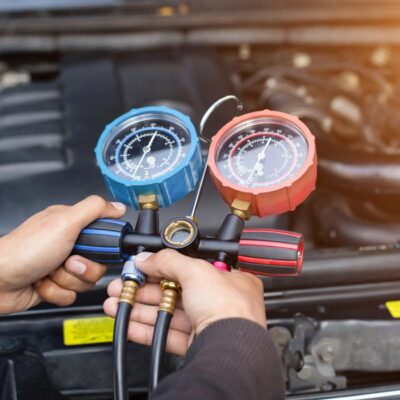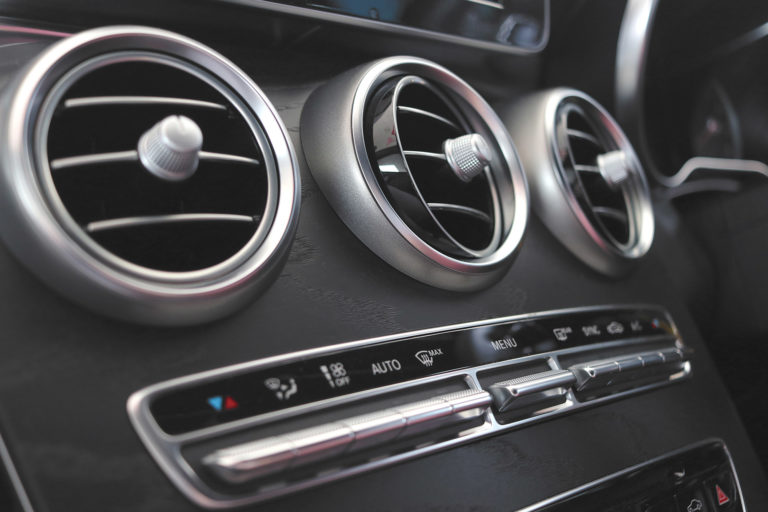Auto AC and Heat Service: Identifying Major Problems and Remedies
During the cold and hot periods of the year, your car’s air conditioning and heating unit always come through, making your shuttles bearable. With these attributes, they rank as essential vehicle components you should always keep in impeccable condition.
However, most drivers refuse to embark on an auto AC and heat service until the system collapses.
On the other hand, when there’s an obvious fault with the air conditioning unit, some drivers are still reluctant to take the vehicle for an auto AC and heat service car repair.
Call Nationwide Report’s Car Genius™ from RepairPal at 1-877-671-3040 from 9am-6pm ET, Monday through Friday.
Home » Resource Center » Auto AC and Heat Service: Identifying Major Problems and Remedies
Reasons for AC and Heating Unit Problems
Although you’ll find both connected in the vehicle, the air conditioning and heating units are separate entities, functioning through distinctive mechanisms to produce varying results.
The air conditioning (AC) unit fields components like the compressor, expansion valve, and heat exchangers made up of an evaporator and condenser. Your car’s engine drives the compressor to compress and pump a refrigerant fluid periodically alternating between liquid and gaseous forms through the air conditioning unit.
The high-pressure refrigerant travels through a valve, reducing its temperature and pressure before passing into the evaporator present on the passenger’s side. Problems with the air conditioning and heating system often arise from problems in the components of both units.
Possible faults in the air conditioning (AC) system can arise from:
- Diminishing refrigerant
- Faulty compressor
- Faulty compressor clutch
- Defective evaporator
- Trouble with the expansion valve
- Weak serpentine belt
Conversely, heater issues occur due to the following:
- Presence of air in the coolant
- Low level of coolant
- Problems with the thermostatic
- Faults in the heater system’s core
Although these units are separate, problems with the heating, ventilation and air conditioning (HVAC) control can hinder both from functioning. For instance, a spoilt blower motor prevents air delivery into the car.
Also, fan switch issues make it impossible to regulate the blower fan speed. Other possible faults that could hamper the car’s auto AC and heating system include a spoilt relay, a blown fuse, and shorts in the electrical wiring.

Potential AC Issues Your Vehicle Might Encounter
Air conditioning units can develop various faults during usage. Usually, the flaws affect the optimal functioning of your vehicle’s air conditioning system. However, you might be unable to recognize these issues whilst they develop. Therefore, it’ll be best to take your vehicle for routine auto AC and heat service car maintenance.
Here are some major issues your car’s air conditioning (AC) system can present:
The Air Isn’t Cold
Sometimes, your AC is on, and while passengers may feel air coming out of the vent, it never gets cold. When this happens, the leaking refrigerant is the root cause.
The refrigerant is crucial to the air conditioner’s cooling process. Cool air in the vehicle’s chamber comes from a stepwise compression and a subsequent reduction in refrigerant pressure and temperature by distinctive air conditioning parts. Most of these AC components won’t work without the refrigerant.
Refrigerant leaks can happen suddenly During certain periods, a hole might form in the AC unit’s connection, hoses, condenser, or compressor.
In some cases, the evaporator may even rupture.
Once these defects occur, the refrigerant leaks through the hole or rupture, preventing the air from getting cold.
The most concerning fact about refrigerant leaks is that they can go unnoticed. Thus it’s challenging to identify as the liquid instantly evaporates upon exposure to the environment.
To confirm refrigerant leaks, you’ll require professional service to diagnose and solve the problem correctly. A top-notch AC technician will put a fluorescent tracer die and refrigerant into your car’s air conditioning unit. The next step involves operating the AC unit and looking for leaks using a blacklight.
After they’ve identified all the leaking regions, they can commence repairs and conclude proceedings with an evacuation and recharge. Once done, your AC unit will start producing cold air again.
AC Vent Isn’t Producing Air
Sometimes, you can discover your air conditioning vent isn’t producing air. Albeit enabled, the AC unit doesn’t facilitate any output.
This problem is often complex and difficult to pin down. Thus, you’d need to consult an expert car technician to conduct proper checks in the system and nail the origin of the problem.
Usually, skilled technicians thoroughly investigate the following components:
Fuse or Relay
One reason your air conditioning unit isn’t producing air might be due to a blown fuse. The fuse is responsible for supplying the power necessary to keep the blower motor working.
As such, if the fuse is blown, a power supply disruption to the blower motor occurs, thereby preventing the flow of air through the vent.
The problem can also originate from a bad relay. This part takes small amounts of electric current within the air conditioning (AC) unit and utilizes it to regulate the more significant necessary for ventilation. Thus, when the relay is bad, it cripples the AC unit.
Blower Motor or Blower Resistor
Experts have discovered that blower motor failure and deterioration is often associated with the failure of an AC unit. The blower motor acts like a regular fan in the system, pushing air through the vent into the vehicle’s chamber.
However, your blower motor can weaken due to age or wear off from constant use causing a malfunction that stops airflow through the vent.
The air conditioning (AC) unit has a blower resistor that works alongside the blower motor to regulate the level and speed of released air. Due to its presence, you can go through different air levels and rates spanning from low, medium, and high, depending on your preference.
Damage to the blower resistor also affects the blower motor, resulting in an inability to generate air.
Belts and Hoses
Every car AC unit has a network of belts and hoses essential to its seamless operation. As time goes by, these parts become prone to leaks, detachments, and blockages.
When any of these scenarios occur, it affects the air conditioning system’s ability to produce air through its vent.
Air Intake
Generally, air flows into the car through two channels. The vents on the windshield’s lower portion serve as a suitable inlet for air. On the other hand, air gets into the car by recirculation inside the cabin.
Air supply through both routes can be obstructed by a blocked filter or other materials. If a blockage occurs, the AC vent may produce little or no air.
Produced Air is Cool But Doesn't Get Cold
Specific drivers or their passengers might realize that while the AC unit produces air, it’s only cool and hardly gets cold. When you experience this problem, it can be due to issues with the refrigerant, a clogged or faulty condenser, or a clutch system malfunction.
Refrigerant Issues
When air from an AC unit fails to get cold, the primary cause is a drop in refrigerant level within the system.
Due to its vital role, a decrease in refrigerant quantity can reduce pressure in the air conditioning system.
The pressure drop stops the clutch from activating the compressor to commence its cycle.
The result?
Cool air coming out of the vents.
Clogged Condenser
The condenser handles refrigerant conversion from the gaseous state through heat removal to the liquid form vital for producing cold air. If the condenser is blocked, air coming out of the vent won’t be cold.
Clutch System Malfunction
A clutch system failure halts the AC’s compressor from functioning. When this happens, condensing the liquid refrigerant into gas becomes impossible. Therefore, air flowing out of the vent won’t get cold.
An expert in AC and heat service car repairs will check these components for clogs, damages, or defects.
After ascertaining any shortcomings, they might repair or outrightly replace your car’s air conditioning system.
Mildew Smell From the Air Conditioning Unit
Sometimes, it’s possible to have a terrible mildew odor coming off vents once the air conditioning (AC) system is turned on. The incidence occurs more in rarely used AC units and. older air conditioning units or AC units.
It also occurs in systems used at maximum setting.
Odors from the AC vent are due to bacteria, mold, or fungi development within the unit, especially behind the evaporator’s dashboard.
High moisture content, usually heightened when using the maximum setting, creates a “breeding ground” for these organisms. Also, air filters can accumulate dust, dirt, and other pollutants, producing a terrible odor.
Fixing the aforementioned issues often demand an air filter replacement. If this doesn’t solve the problem, the technician might apply antibiotics to the evaporator in a bid to kill off the molds and other organisms.
AC Produces a Strange Noise When Activated
Sudden strange noise from any part of your vehicle is a warning sign of a possible problem. Unlike other parts of your vehicle, the air conditioning unit works calmly.
Thus, noise from the system should set you on alert.
The noise can result from a blockage in a portion of the AC unit by leaves or other debris. However, it could be a tell-tale sign that system components are failing.
For context, squealing sounds accompany a worn-out bearing. In contrast, the AC unit can rattle following a compressor clutch failure.
When faced with strange AC noises, resist the urge to keep driving the car. Instead, take your automobile to a professional to validate the root cause before deciding if a repair or replacement is necessary.
Moisture on the Floorboards
Bacteria can nest in the evaporator coil located at the AC’s heater box underneath the dashboard.
As air flows, bacteria will mix with condensed water, creating a “foul-smelling” slime deposited on the air conditioner’s fin. These deposits keep building up till it clogs the drain line.
Once this happens, condensed water fills the heater box before overflowing and dripping onto the vehicle’s floor.
If you notice dampness in your car’s floor, drive straight to an auto mechanic. Once there, they’ll determine the main cause of the clog before proceeding to repair or replace the drain line.
AC Unit Abruptly Alternates From Cold to Hot
Another sign of AC malfunction is the sudden change from cold to hot air in the vehicle.
This scenario is traceable to an expansion valve issue. The valve releases the right amount of refrigerant to the evaporator and when it becomes clogged, it stops refrigerant from getting to the evaporator.
Solving this issue involves having a technician check the system’s pressure and observe the other parts for clogs and possible issues.

Parting Shot
Your vehicle’s air conditioning unit can malfunction for diverse reasons. The problems often accompany clogs or malfunctions in crucial system components like the evaporator, condenser, drain line, and so on.
Faults in any of these parts will most likely interrupt the supply of cold air or produce foul odor in the vehicle.
Solving air conditioning unit issues requires contacting an expert technician to assess the system in-depth.
On This Page
- Reasons for AC and Heating Unit Problems
- Potential AC Issues Your Vehicle Might Encounter
- Produced Air is Cool But Doesn't Get Cold
- Mildew Smell From the Air Conditioning Unit
- AC Produces a Strange Noise When Activated
- Moisture on the Floorboards
- AC Unit Abruptly Alternates From Cold to Hot
- Parting Shot
FIND A REPAIR CENTER
Common Issues & Problems
- Alternator or Battery Issues
- Brake Pad Problems
- Camshaft Problems
- Car Isn't Starting?
- Car Tune-Ups
- Electrical Problems
- Damaged Cylinder Head Issues
- Engine Sputtering
- Fuel System Problems
- Oil Leak Issues
- Steering Wheel Problems
- Suspension Problems
- Tire Problems
- Transimission Problems
- Visibility Problems
- Warning Light Problems


